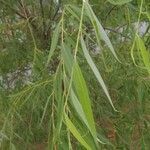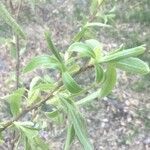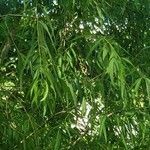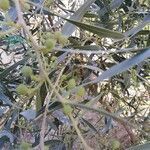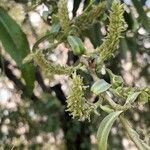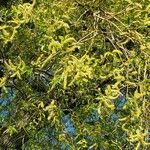Tree or shrub with mostly drooping, reddish branches. Twigs when young pilose, later glabrous, and when older with distinct, acute, axillary buds. Leaves 2-5 mm petioled, linear-lanceolate, 6-12 by 0.5-1.25(-2.25) cm, shiny above, glaucous or dull green below, base blunt, apex acute, margin finely serrate; midrib prominent, whitish. Catkins short, on twigs of the previous flush, terminal on short shoots with a few, small, entire leaves. Rhachis short-haired, rather dense-flowered. ♂ Flowers: Bracts thin, ovate-elliptic, 1.5 mm long, with 3 distinct nerves and cucullate top, white-villous only at the base. Stamens 2, connate at the very base, 4-4½ mm long; filaments filiform, somewhat haired at the base; anthers small. Disk not very fleshy, adaxial part about as large as the abaxial part, elliptic, 2-3 times as short as the bract. ♀ Flowers (not found in Malaysia): Bracts acute, 2-2.5 mm, only at the base vaulted and haired. Ovary nearly sessile, conical, not or somewhat longer than the bract, glabrous, with a distinct, 4-lobed style. Disk only adaxial, flat, 1 mm long.
Trees to 18 m tall; bark grayish black, irregularly furrowed, Branchlets pendulous, brownish yellow, brownish, or slightly purple, slender, glabrous. Buds linear, apex acute. Stipules lanceolate or ovate-orbicular, those of shoots obliquely lanceolate; petiole (3-)5-10 mm; leaf blade narrowly lanceolate or linear-lanceolate, 9-16 × 0.5-1.5 cm, abaxially light green, adaxially green, both surfaces glabrous or slightly pilose, base cuneate, margin serrate, apex long acuminate. Male catkin 1.5-2(-3) cm; peduncle short; bracts lanceolate, abaxially pilose. Male flower: glands 2; stamens 2, ca. as long as to longer than bracts, ± long pubescent at base; anthers reddish yellow. Female catkin 2-3(-6) cm, with 3 or 4 leaves on peduncle; bracts lanceolate, 1.8-2(-2.5) mm, abaxially pilose. Female flower: gland adaxial; ovary ellipsoid, glabrous or minutely pubescent proximally, sessile or subsessile; style short; stigma 2-4-parted. Capsule slightly greenish brown, 3-4 mm. Fl. Mar-Apr, fr. Apr-May. 2n = 63, 72, 76.
Large spreading tree to c. 30 m high; bark fissured, grey. Smaller branches, branchlets and shoots long, slender, pendulous. Shoots green or brownish green, rather brittle. Shoots and lvs with appressed hairs, soon glabrous. Buds very small, soon glabrous. Petiole 5-8 mm long. Lamina 6-13 × 1-2 cm, narrow-lanceolate, glaucescent or glaucous below, slightly shining above, rather remotely serrulate; apex long-acuminate. Lvs subtending catkins generally c. 3 × c. 0.8-1 cm; apex acute or short-acuminate. Stipules on long shoots with curved apices. Catkins ♀, appearing with and after lvs on short leafy shoots, 1.5-3 cm long, narrow-cylindric, often curved; rachis villous. Bracts 2-2.5 mm long, narrow-triangular or lanceolate-oblong, green; margin not incurved; apex acute. Gland 1, 0.5-0.6 mm diam., broadly rectangular or almost square, sometimes 2-lobed. Ovary sessile, glabrous.
Tree to 20 m; crown spreading; main branches ascending; branchlets (in naturalised plants) pendulous, often for the final 2–3 m; twigs shiny, glabrous, yellow-brown to grey-brown; bark grey, becoming deeply furrowed. Leaves lanceolate to linear, very long-acuminate, sinuous, thread-like at tip, 50–130 mm long, 5–25 mm wide; finely but sharply dentate, each tooth tipped by a narrow, forward-pointing gland; glabrous; base cuneate; upper surface green, lower glaucous; petiole 3–8 mm long, glandless stipules ovate-acuminate, c. 5 mm long. Catkins 13–20 mm long (to 25 mm in fruit), c. 5 mm diam., erect or spreading, shortly pedunculate on short shoots with much reduced leaves at base; floral bracts persistent, ovate, acute; nectaries 1 or 2. Stamens 2. Fruits sessile, conical, with sessile stigma.
Tree to 12 m, the cult. and escaped forms with long, slender, pendulous, olivaceous or yellow-brown, glabrous or subglabrous, basally brittle twigs; stipules lanceolate, 2–7 mm, or none; lvs lance-linear, 8–12 × 0.5–1.5 cm, mostly falcate, long-acuminate, finely but unevenly spinulose-serrulate, glabrous, yellowish-green above, ± glaucous beneath; petioles 7–12 mm, tomentose, often glandular above at the tip; catkins with the lvs, 1–2.5 (staminate to 4) cm, on peduncles 0.5–1.5 cm with 2–4 tiny lvs; scales pale yellow, crinkly-hairy, ± persistent; stamens 2; frs narrowly ovoid, 1.5-2.5 mm, sessile; style almost obsolete; stigmas brush-like (unique among our spp.); 2n=76. Native of China, sparingly escaped from cult. in our range.
Tree, 4.5-18.0 m high, terminal buds lacking, winter buds with 1 outer scale; branchlets slender, hanging vertically, almost to ground. Leaves alternate, petiolate; lanceolate, margins serrulate. Inflorescences small catkins. Flowers unisexual, entomophilous; borne in axil of an entire bract, 1 or 2 small nectariferous glands at base. Female flowers single ovary, composed of 2 carpels, sessile or stipitate; ovules 4-8, arranged on 2 placentas; style short, 2 short stigmas. Flowering time Aug.-Oct. Fruit a sessile capsule, dehiscing by 2 recurving valves.
A spreading tree. It loses its leaves during the year. It grows 12 m tall. The end branches hang down. The trunk can be 75 cm across. The primary branches are brittle. The leaves are alternate. The leaves are 2-12 cm long by 0.5-2 cm wide. There are teeth along the edge. The flowers or catkins are of one sex.
Tree, up to 9 m high. Branches hanging vertically. Leaves tapering to a long-acuminate apex. Female flowers sessile.
